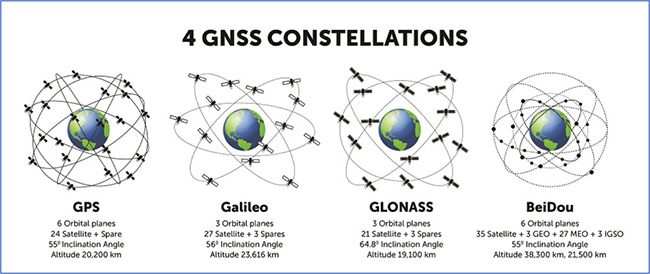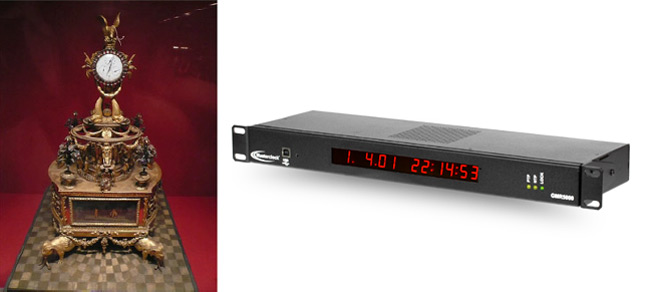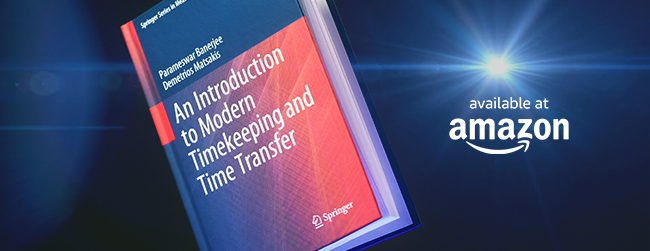06/23 By Dr. Matsakis
An Introduction To Modern Timekeeping and Time Transfer
When Dr. Parameswar Banerjee asked me to coauthor a book about the science of timekeeping I turned him down. Twice. Partly because I wasn’t sure I was qualified [1]. It certainly wasn’t for lack of love. I love the field of timekeeping. The very concept of time intrigues me, even though it is probably just a manifestation of a deeper reality. To understand it is to understand how everything in life fits together—from syncing with GPS satellites to probing the fundamental secrets of our universe [2].
What changed my mind was thinking about how much I would have liked a book like this when I first got hired at the U.S. Naval Observatory. The writing process turned out to be as intense as I feared. My entire contribution to society in the last six pre-publication months was largely devoted to obsessively tracking down and fleshing out details for the book – from proofreading and securing copyright permissions to finding explanations for apparent inconsistencies. For example, over several days I was totally confused as to why engineers liked to set the derivative gain to zero in PID loops. Then I realized that physicists like me use different equipment, so an engineer using a frequency gain of zero when using a voltage-controlled oscillator was equivalent to me setting it to one half when using a micro-stepper. It was that engrossing for Param in India too, as judged by the fact that every morning I’d find one or more emails him. And by the time he woke up there would be some from me waiting for him.
It took two years, but finally “An Introduction to Modern Timekeeping and Time Transfer” has rolled off the printing press and landed on bookshelves (or at least the Amazon warehouses).
Being able to complete it and feel the relief that comes from that are the few differences between writing a book and having a baby, which requires constant care for decades. Also, no baby pictures. But now I’m going to act like any parent by showing you some pictures from the book [3]. For example, the introductory chapter starts with a local artist’s conception of the emergence of time and matter from the Big Bang:
 The laws of physics, as we know them, emerged 10-32 seconds after the Big Bang, give or take. Attribution: Shanthi Chandrasekar, photography by Tony Ventouris.
The laws of physics, as we know them, emerged 10-32 seconds after the Big Bang, give or take. Attribution: Shanthi Chandrasekar, photography by Tony Ventouris.
The historical chapter shows how clocks have gotten more and more precise over time. Others have made similar drawings, but we modernized it a bit. The grey-blue column in the picture below is the atomic clock era. This exponential advancement is much more rapid than Moore’s Law for computers, and in fact modern clocks are more precise 24x7 than anything else ever built to measure anything.
 Much of the progress has been directly or indirectly government-funded, because society as a whole benefits from better time.
Much of the progress has been directly or indirectly government-funded, because society as a whole benefits from better time.
The section on how atomic clocks work starts out with a very simple picture. Electrons change energy inside of an atom and give off radiation, whose frequency acts like the oscillations of a pendulum to tell the time. It’s actually a little harder to talk to atoms than it looks, but I hope that chapter has done justice to the many brilliant scientists, including many Nobel Prize winners, who have devoted their lives to advancing the field.
 Quantum mechanics says the atomic electron can have certain energies, but no others (attribution: Jabberwok).
Quantum mechanics says the atomic electron can have certain energies, but no others (attribution: Jabberwok).
The chapter on how to evaluate clock performance starts with the standard dartboard analogy, but unlike the others it distinguishes between precision and accuracy while introducing a recently-defined concept of trueness. Call us politically correct.
 Do not confuse precision with accuracy, or accuracy with trueness. Only the top left depicts high accuracy.
Do not confuse precision with accuracy, or accuracy with trueness. Only the top left depicts high accuracy.
Even to measure clock precision is an art in itself, well deserving of another chapter. The next picture shows how we measure time using voltage measurements.
 The standard model for the output of an atomic clock does well, though there are imperfections.
The standard model for the output of an atomic clock does well, though there are imperfections.
It doesn’t do any good to know the time if you can’t share it. We call this time transfer. There is a chapter on the old ways like dropping time balls, and there are three chapters on GPS and GNSS.
 The three "imitation" satellite systems do more than flatter GPS; they complement it (attribution: J. Van Sickle, GPS for Land Surveyors, CRC Press).
The three "imitation" satellite systems do more than flatter GPS; they complement it (attribution: J. Van Sickle, GPS for Land Surveyors, CRC Press).
Computer people might be especially interested in transferring time between computers via NTP and PTP. This is extremely important for datacenters, especially the Amazon ones that can sell you the book [4]
 Time from a primary source, like NIST, is spread over the internet in ways that can be authenticated (attribution: Lombardi et al, PTTI 2014).
Time from a primary source, like NIST, is spread over the internet in ways that can be authenticated (attribution: Lombardi et al, PTTI 2014).
Everything we do now is high tech, but if defined by direct day-to-day expense, Two Way Satellite Time Transfer and time transfer via optical fibers are the ultimate:
 Calibrating TWSTT systems requires shipping equipment and humans to remote and sometimes exotic sites (attribution: USNO).
Calibrating TWSTT systems requires shipping equipment and humans to remote and sometimes exotic sites (attribution: USNO).
 This figure is from Chen et al,, Sci. Rep. 5, 18343 (2016). Optical fibers now transport time between labs all over Europe.
This figure is from Chen et al,, Sci. Rep. 5, 18343 (2016). Optical fibers now transport time between labs all over Europe.
What I personally like most are timescales – how to average clock times as well as how to speed up or slow down a clock that is extremely precise in the short run, so it agrees with a more accurate one in the long run. They embrace the full beauty of the timekeeping art. And like all beauty, it’s in the eye of the beholder. The perfect timescale depends on your requirements:
 I probably left out some considerations.
I probably left out some considerations.
And finally, either the most exciting or most humbling part of the book is that it will become more and more out of date as time progresses. Our final chapter is on applications pointing towards the future.
 While Pulsar timing can't compete with clocks on Earth, interstellar space travel will need better clocks plus pulsars (attribution: NASA).
While Pulsar timing can't compete with clocks on Earth, interstellar space travel will need better clocks plus pulsars (attribution: NASA).
I’d like to say that the book itself will contribute to the advancement in timekeeping and time transfer, but all I can do is promise to write a second edition before my time runs out.
Footnotes
[1] Long ago I was surprised by a press release that described how a certain Cardinal felt when he became Pope. Along with a string of positive adjectives the new Pope also felt “humiliated”. I understand that now.
[2] Of course even if you ignore the reality business, the mechanics of timekeeping are fascinating – they have something for everybody. From artistic timepieces to sleek modern clocks.
 Antique clock in Beijing's Forbidden City (attribution: Gruntzooki), and Masterclock’s GMR5000.
Antique clock in Beijing's Forbidden City (attribution: Gruntzooki), and Masterclock’s GMR5000.
The experimentalists can get their hands greasy in the laboratory making devices that measure frequency more precisely, 24-7, than any other thing ever measured by anybody—while the businessmen can build a clocks cheaper than anybody else, yet maintain a modicum of precision. The math can be deceptively simple, because in the absence of absolute time all you really can do is subtract two clocks. Yet that very simplicity has large statistical consequences that even now have not been completely worked out. In terms of data analysis, it is often possible to do what you want on laptop – although the terabits of data made available by satellite systems enable the use of time to probe the secrets of the universe, from the Big Bang to the Quantum Foam.
[3] The pictures all are from the book. Springer holds the copyright for those Param and I made, otherwise the attributions show were we got them. But speaking of pictures, the only part of writing that affected my sleep was when I got the printer’s proofs and found the pictures I’m showing here had all been moved from the very start of their chapters to silly places a few pages further down. It turned out the layout people were just following the rule that every picture should be where it is first referenced, but we didn’t reference them because they were supposed to be mood-setting curiosity-arousers. The solution was to add a phrase on the first sentence of every chapter, like “as shown in Figure 1..."
[4] The computer networks run by Springer, my publisher, are probably just as time-critical, though their volume is less. You can get the book from Amazon or from here:
https://link.springer.com/book/10.1007/978-3-031-30780-5
About Dr. Demetrios Matsakis
 Dr. Demetrios Matsakis attended MIT as an undergraduate and received his PhD in physics from UC Berkeley, where he studied under the inventor of the maser and laser; and built specialized ones in order to observe interstellar dust clouds where stars are born. His first job was at the U.S. Naval Observatory, building water vapor radiometers and doing interferometry to observe quasars and galaxies at the edge of the observable universe. After developing an interest in clocks, Dr. Matsakis would spend the next 25 years working hands on with most aspects of timekeeping – from clock construction, to running the USNO’s Time Service Department, to international policy. He has published over 150 papers and counting, but gets equal enjoyment out of beta-testing his personal ensemble of Masterclock products.
Dr. Demetrios Matsakis attended MIT as an undergraduate and received his PhD in physics from UC Berkeley, where he studied under the inventor of the maser and laser; and built specialized ones in order to observe interstellar dust clouds where stars are born. His first job was at the U.S. Naval Observatory, building water vapor radiometers and doing interferometry to observe quasars and galaxies at the edge of the observable universe. After developing an interest in clocks, Dr. Matsakis would spend the next 25 years working hands on with most aspects of timekeeping – from clock construction, to running the USNO’s Time Service Department, to international policy. He has published over 150 papers and counting, but gets equal enjoyment out of beta-testing his personal ensemble of Masterclock products.


